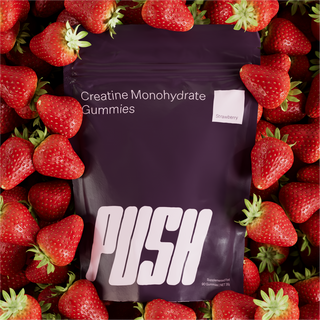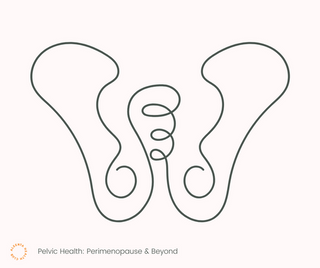Why we’re busting to talk about the uncomfortable.
Throwing some sun on the shadowy topics destigmatises the "uh-oh” things that happen in our bodies.
We want to help you get out of your head and into the physio clinic for answers!
The more comfy you are with your pelvic health, the more likely that you’ll take control and prevent, manage, or heal from whatever’s going on (instead of sticking your head in the sand and hoping it just goes away – we’ve all been there).

Urinary Incontinence (UI)
The accidental, uncontrollable loss or leaking of urine is one of the most common pelvic health issues experienced by Australian women – almost 40 percent of us experience UI during our lifetimes (i).
And guess what? More than half of those reporting UI are aged under 50.
UI in some cases is closely linked to pelvic organ prolapse (POP), and the effects of pregnancy and childbirth on your pelvic muscles, fascia and ligaments. We’ll get to prolapse in the coming articles.
For now, whizzing on through different types of UI with your amazing Glide Physio and Pilates women’s health physiotherapist, Ellie Parnell.
Stress UI vs Urge UI.
“These are two very different beasts with a range of contributing factors and treatments,” says Ellie.
Leaking when you cough, sneeze, laugh, run or jump? Stress UI occurs when the myofascial structures that control your bladder can’t hold up against increased intra-abdominal pressure.
Have you ever been suddenly desperate to go to the toilet when you hear running water despite not having a full bladder? Or unable to hold your wee when you get home and are trying to get your key in the door? Urge UI can be present in people with strong, healthy pelvic floors.
Let’s get under the skin.
Stress UI

Ellie says this issue can pop up due to a lack of muscular engagement before quick, explosive movement like jumping; as a result of sustained pressure like coughing during a bad chest infection; or of course in pregnancy as the weight of baby and placenta press down.
“Our urinary sphincters, muscles that wrap around the urethra, keep wee up in the bladder until we’re sitting ready on the loo,” says Ellie. “They need to be strong enough to resist downward forces, along with all the other tissues that hold everything properly in place.”
Factors that reduce urinary bladder control can include:
- Hormones: fluctuations in oestrogen levels throughout your life cycle (pregnancy, postpartum & menopause in particular), or even in your monthly menstrual cycle, can make it tricky to hold in wee at certain times!
- Damage to the endopelvic fascia and deep pelvic floor muscles: these hold your bladder up nice and high and assist the pelvic floor muscles to keep your urethra closed when functioning well. About 30 percent of the women who have a vaginal birth experience some trauma to the perineum (the skin between vagina and anus), levator ani and other pelvic floor myofascia.
- Nerve damage during pregnancy & birth: the pudendal nerve supplies many muscles of the perineum and is vulnerable to stretch injury during childbirth, especially during a long second (pushing) stage of labour or in women who birth bigger babies. This damage is usually reversible with treatment and time but can initially lead to difficulty in bladder and bowel control.
- Pelvic organ prolapse: myofascial weakness in your pelvic floor can result in prolapse, which can affect your ability to control pelvic organ function.
- Muscle-loss with age (sarcopenia): your tissues can lose their integrity as the years climb, compounded by all the stories held in your body – pregnancy, stress, chronic health conditions, coughing and constipation just to name a few. Endopelvic fascia and ligaments can also become time-weary.
Urge UI

But, why?
Ellie says your bladder walls are made of smooth muscle controlled by your autonomic (involuntary) nervous system, like in your digestive tract.
The bladder has “epithelial” cells on the inside, which sense mechanical and chemical changes and pass the messages onto your nervous systems.
A normal bladder has a capacity of approx 500-600ml. It should stretch to fill at least halfway before the urge to urinate is first noticed; most people can defer the urge until a suitable time to go to the toilet.
Some changes, including acidity or the presence of harmful bacteria, can trigger reflex contractions that make you feel like you need to wee, even if there’s not much fluid in there. Psychological factors can also play a big part in UUI.
Factors that can trigger bladder muscle to squeeze prematurely:
- Overactive bladder (OAB): like prolapse, OAB is its own condition – not everyone who has it will experience incontinence but it can certainly be a factor in Urge UI.
- Age: your bladder walls can become stiffer and less stretchy over time (the same can happen after radiation therapy in the pelvic region), reducing volume capacity.
- Neurological conditions, stress & anxiety: these can affect the chatter between your brain and organs, including your bladder; tension as a result of stress & anxiety can also contribute to decreased autonomic communications.
- What you consume: coffee, tea, alcohol and fizzy drinks can all irritate or stimulate the bladder, making it contract more readily.
- Other pelvic health issues: pelvic organ prolapse, chronic pelvic pain, urethral sphincter weakness, constipation strain & overactive pelvic floor muscles can contribute to urgency.
- Untraining: when you empty your bladder too frequently “just in case”, this can become a habit your body learns and your ability to hold fluid decreases.
- Infection: bladder infections, cystitis & UTIs irritate the epithelial cells, making them more sensitive and your bladder walls more likely to contract.
Then there’s Mixed UI!
About 1 in 3 people who experience UI get the combo. Not the kind with chips and a drink.
“Mixed UI can be more urge dominant, or more stress dominant,” says Ellie. “Treatment is often prioritised based on which symptoms are the most bothersome.”
How do I regain control?
Step 1: Get assessed.
Ellie says it’s super important to have a women’s health/pelvic health expert suss out the type and causes of your UI before you dive straight into a Kegel regime as the wrong exercises could exacerbate your probs. A pelvic health professional can:
A pelvic health professional can:
- Check your symptoms
- Determine the causes
- Offer/suggest testing (eg. keeping a bladder diary, urine testing or providing a vaginal examination/ultrasound), or refer you on to a specialist if required
- Help you manage your symptoms and reduce discomfort
Step 2: Know your options.
If it’s determined that you have UI, your women’s health physio will offer you various therapeutic approaches based on your stage of UI, your personal preferences and what would be most beneficial in your case. They will also discuss medical options with you, and can recommend a women’s health GP or specialised imaging if required.
Step 3: Management & healing.
Pelvic health physios work with you, to help you manage symptoms and recover your pelvic health. The processes differ for Stress UI and Urge UI, as the factors involved can be vastly different!
Therapeutic options for Stress Urinary Incontinence.
1. Pelvic Floor Muscle Training – studies show 30-50 percent of Stress UI cases can be cured with PFMT! If your pelvic floor muscles and endopelvic fascia are in good condition, your physio will help you activate and train the correct muscles. Recent evidence shows that even 12 weeks of consistent PFMT significantly reduces Stress UI symptoms (ii).

2. Vaginal Weights or Cones – sometimes used alongside PFMT. They can be inserted into the vagina for a short period of time each day, while the woman walks around and does her usual tasks at home. Over time the weight is increased gradually as the vaginal muscles get stronger.
3. TENS/e-Stimulation – for use in women who have close to zero pelvic floor muscle activation. A probe is inserted into the vagina to stimulate the nerves via a teensy electrical current. It might sound weird (and it’s cool if it’s not for you) but has been used to great effect.

4. EMG Biofeedback – another internal device that provides visual feedback about what your muscles are doing! Eep, tech is amazing. Electrode pads or a probe measure electrical activity in the muscles. There are modern devices such as the Elvie or Perifit which even connect to your smartphone. EMG is usually not essential, but some women prefer it.
5. Pessaries – intra-vaginal support devices, usually made of silicone or rubber, that support the bladder neck (top of the urethra) and help compress and close the urethra. They are proven to reduce and/or cure Stress UI, and are recommended by the International Continence Society. Pessaries are initially inserted by a healthcare professional (iii).
The medical route.
This path is taken in cases where it’s deemed necessary by a clinician, or due to personal preference. Options include:
1. Oestrogen Cream – often, women who are breastfeeding or post-menopausal will have changes to their urethral tissues that make it harder to keep the urethra closed (and keep your wee in!). If this is you, an oestrogen cream can greatly support tissue health. Your physio will advise whether you should see your doctor for a prescription.
2. Surgical Options – if therapeutic measures are unsuccessful, there are some excellent surgical options which reinforce the damaged fascial and ligamentous supporting structures of the pelvic floor, to hold the bladder and urethra up where they need to be.
Therapeutic options for Urge Urinary Incontinence.
Ellie says treatment for UUI isn’t simply a matter of strengthening your pelvic floor muscles, although having good muscle control can help you keep control and defer the urge to wee.
Treatment focuses on bladder retraining and reducing the urge sensation, including:
1. Bladder diaries to assess when and why the urgency is occurring, and teach urge control techniques. Diaries also help to ID lifestyle factors that need to be tweaked to support reduction in urge, such as saying no to a 3rd espresso.

2. Muscle relaxation and stress management techniques.
3. TENS/e-Stimulation – a gentle electrical current can help desensitise the bladder. “It’s not as bad as it sounds!” Ellie says.
Love our blogs? Let us know.
If this pelvic health blog series helps you breathe a quiet sigh of relief that you’re not alone, gives you courage to confide in a friend, or galvanises you into booking that first appointment to seek help, that’s a win we want to know about! Email us ellie@aleenta.club (our writer Ellie Crozier, not Ellie Parnell the physio) or reach out on socials @aleenta.club
References.
(i) The Continence Foundation of Australia. (2024). Key statistics on incontinence. Department of Health and Aged Care. https://www.continence.org.au/about-us/our-work/key-statistics-incontinence
(ii) Antonio FI, Rodrigues MP, Brooks K, Varette K, McLean L. What improvements in levator ani motor function lead to improvement in stress urinary incontinence signs and symptoms in females? Int Urogynecol J. 2022 Oct;33(10):2735-2747. doi: 10.1007/s00192-021-04931-7.
(iii) Cardozo L, Rovner E, Wagg A, Abrams P. (2023). Incontinence 7th Edition. ICI-ICS International Continence Society, Bristol UK, ISBN: 978-0-9569607-4-0.





